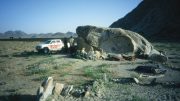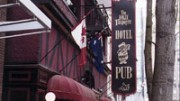Watching news reports about fires in California a few months ago brought back memories of Manitouwadge, Ont., in 1975.
It seems that mines in Canada are always located in remote areas, usually forested. Noranda’s Geco and Willroy copper mines were in that sort of country north of Lake Superior. Everybody in town was talking about the beautiful weather we had been getting that summer. Most years, it was unusual to have two weekends in a row without rain, but this year, it was so dry that the 3,500 town residents were not allowed to water their lawns.
Then, in the first week of August, came word that a forest fire had started just a few kilometres south of town, and the wind was blowing north.
At Geco, they called the men up from underground because the vent fans were pulling smoke down the fresh air raises. I came home from the mine when my wife called and said she could see flames from our upstairs window. I stopped to gas up the car in case we had to evacuate, and there was no regular gas left at the gas station, only high-test. The official word was given out that residents should prepare to evacuate, but everyone was to stay put until we all left together with a police escort. This would take us 56 km south to the Trans-Canada Highway. (Nobody knew it then, but 10 years later that junction would be called “Hemlo.”)
That night, we loaded up the car with suitcases full of everything we needed for us and our two girls, a toddler and new baby. Imagine being told that your home may be destroyed and all you can save is what you can fit in the trunk of your car. We managed to fit in a few irreplaceable mementos and photograph albums.
The next day, waiting around home, I was outside putting a coat of varnish on our front door. (The mines had recently started selling houses to the employees who were renting them.) The woman next door was painting trim on the front of their Willroy house. She called over to me and remarked that maybe we were wasting our time if the houses were just going to burn. The town was so quiet that I think if a car drove down the street too fast it would have started a panic.
At the mine, the guys from the plant had filled a railroad tank car full of water. They hooked up the mine’s “trackmobile” shunting tractor to it, and equipped with a pump and fire hose, patrolled up and down the railway on the edge of town. As they described later, the biggest problem was that every so often, a piece of flaming birch bark would fly up in the air with the smoke from the fire on one side of the tracks. Eventually, one would come drifting down and start a new fire on the other side of the tracks. By hosing down all these new small fires, they were able to keep the big fire away from the town.
Finally, at about 7 p.m., a big red Canso amphibian water bomber flew over town. (We heard later it had been called away from another fire in the Timmins area.) It touched down on Manitouwadge Lake, skimmed along to fill its tanks, then slowly lifted off to just barely clear the rooftops on its way to dump its load on the fire. It made a couple of dozen trips like that until darkness came around 9 p.m., then it flew away east. We were sure glad to see that plane! Some people said later that the water dripping from Canso as it passed over their houses was the only water their lawns got that summer. We slept well that night after being told that the fire was under control.
The next day came shocking news: another fire had started up 25 km from town and was on both sides of the highway! The mines sent all available men, the forestry department brought in more, and soon we had 500 men fighting the fire. After two weeks, the weather changed and it started raining. The fire was brought under control and stopped just 5 km from town. However, there were places you could still see smoke rising out of the bush for months, even after the winter snow came. But every cloud has a silver lining — the mine continued paying my salary, and the extra money I made firefighting was enough to buy our first colour TV!
— The author is a mining technologist based in Yellowknife, N.W.T.




Be the first to comment on "Odds ‘n’ Sods: Forest fire at the mine"